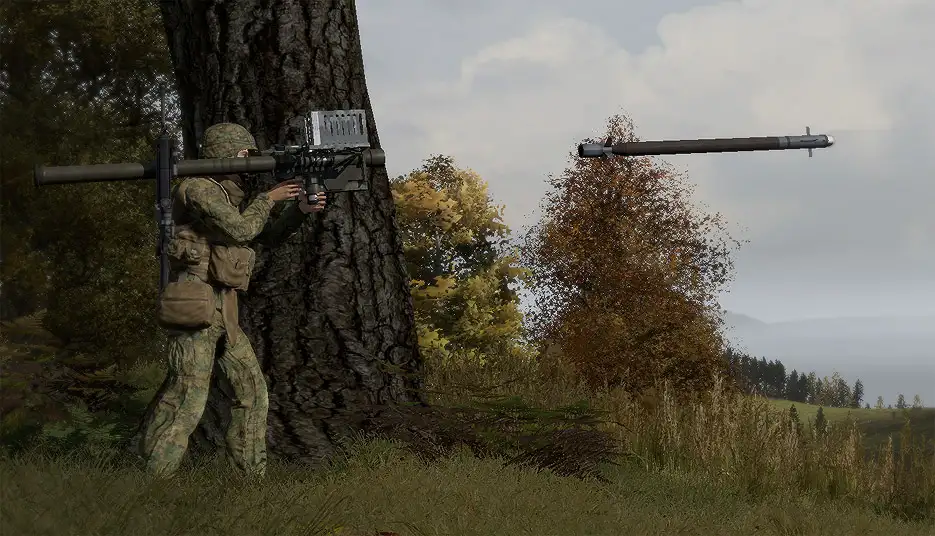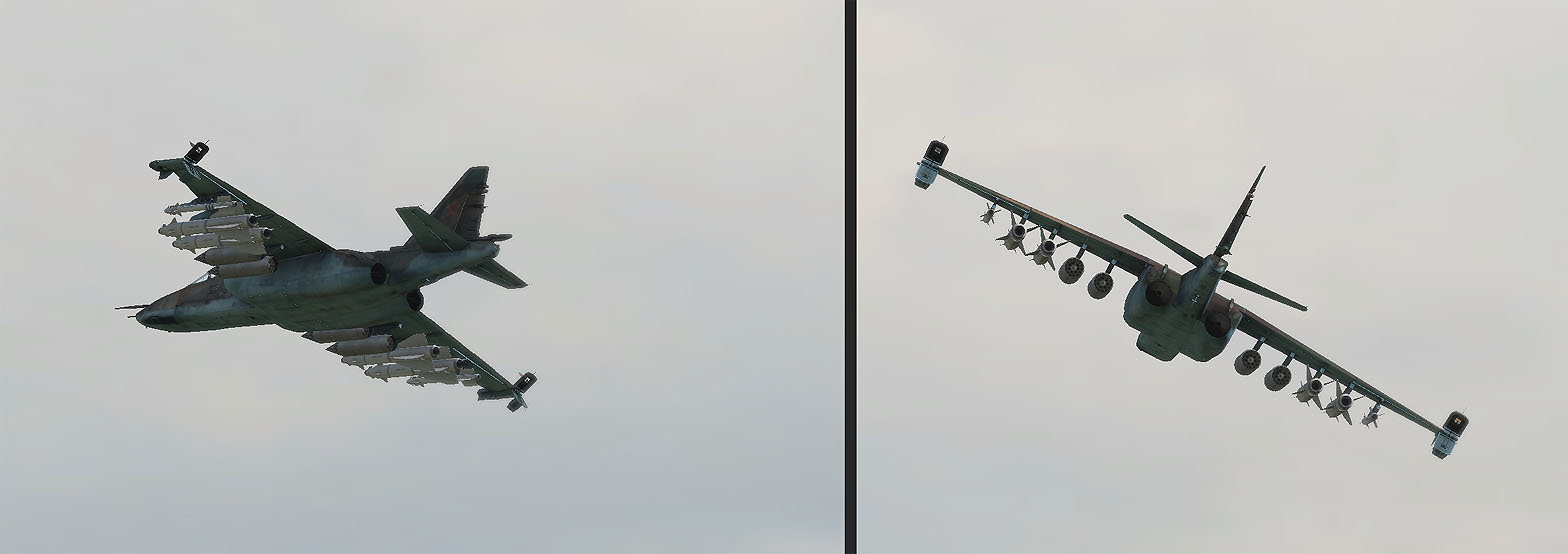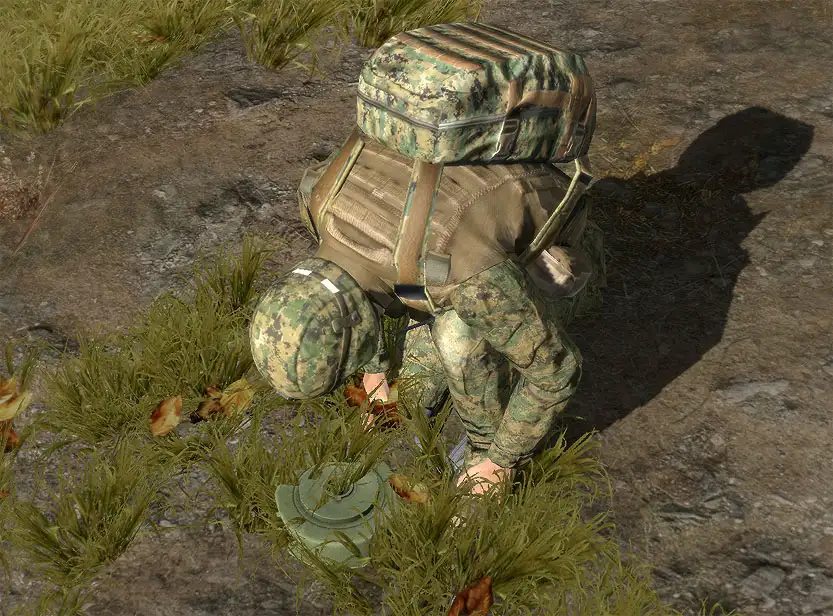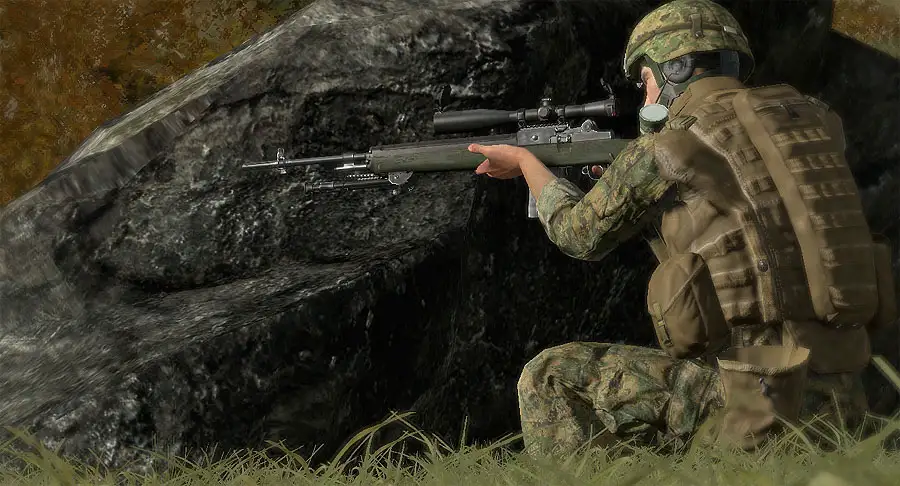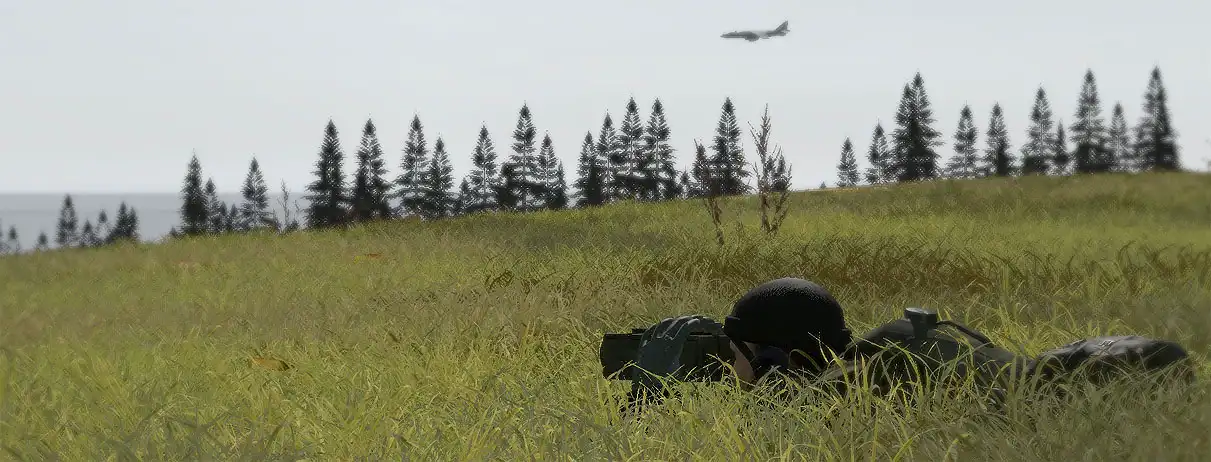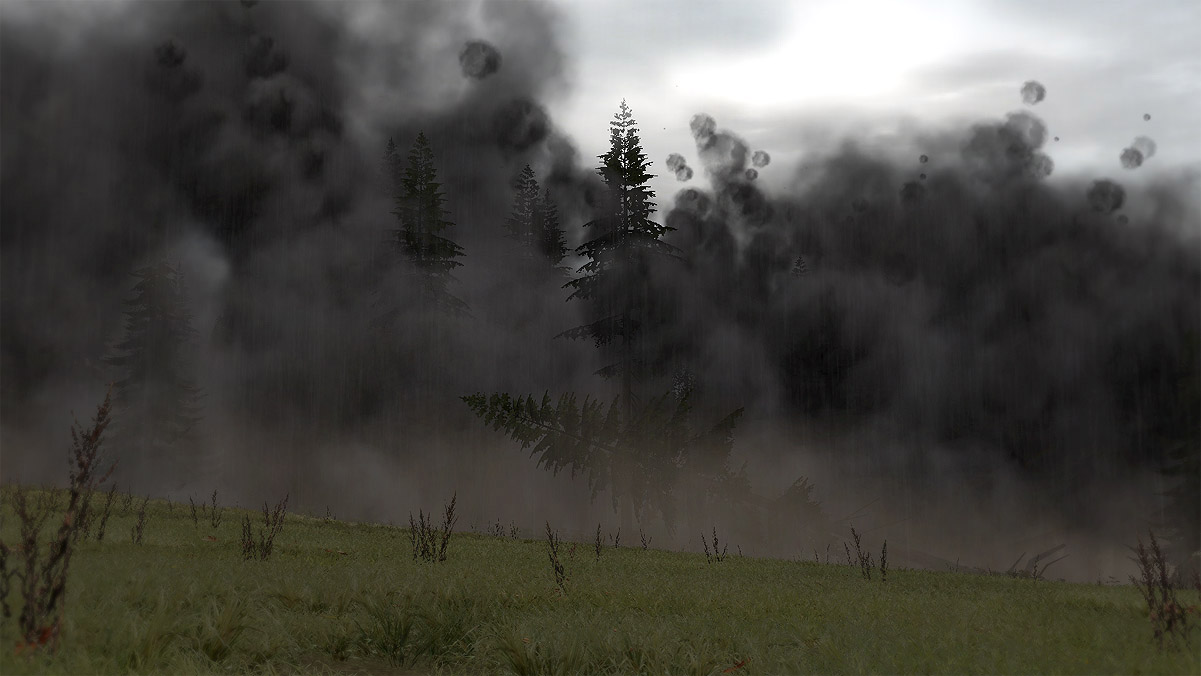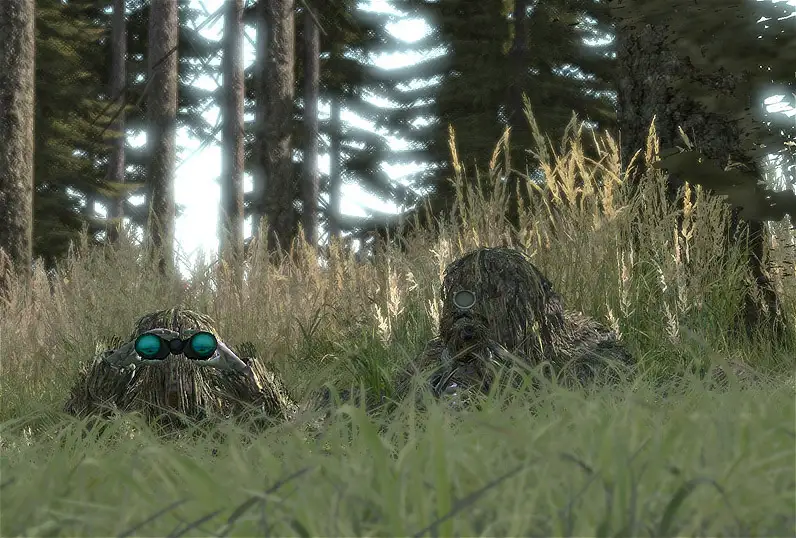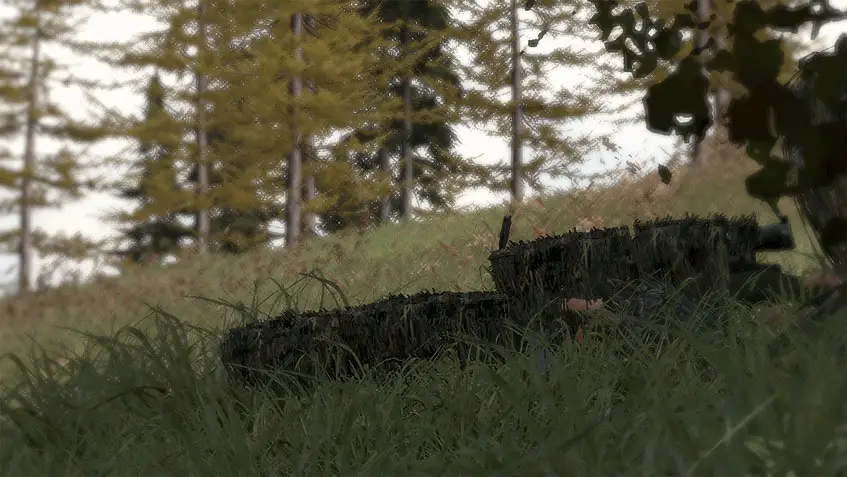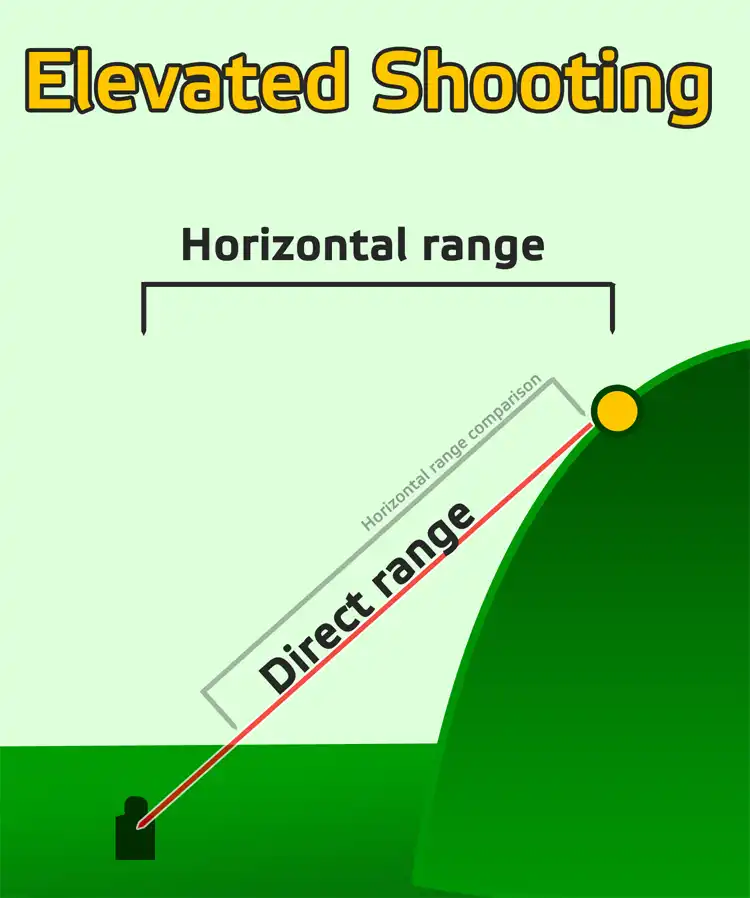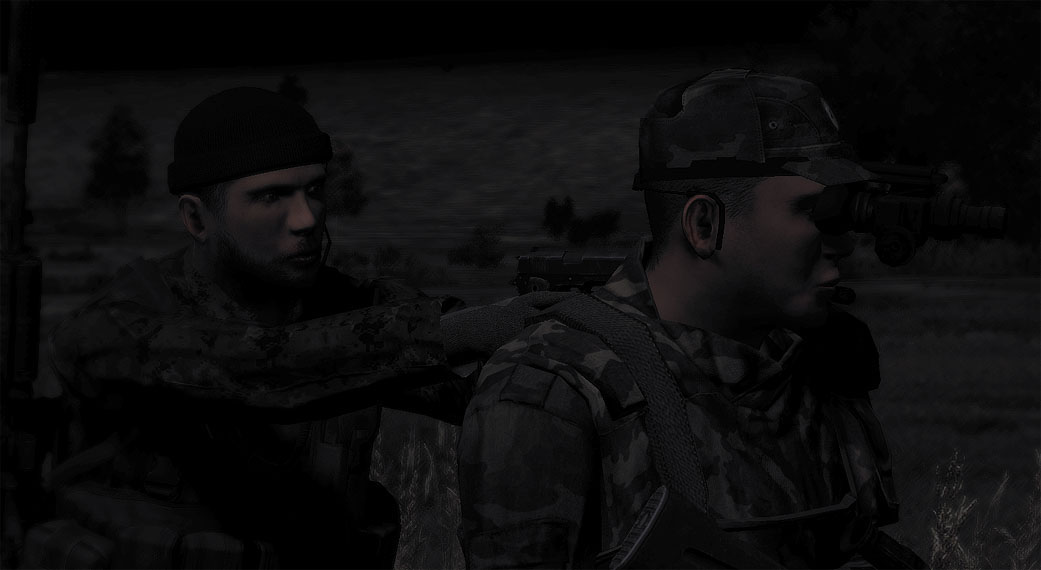![]()
Attachments Theory/Info 
While the ShackTac Platoon carries a great variety of weapon systems organically, it does not have access to all of the best weapon systems available to Marine infantry. The heavier and more specialized weapons in the Marine inventory are typically brought into a mission as 'attachments' from a variety of other organizational structures such as the Weapons Platoon, Weapons Company, Scout/Sniper Platoon, MARSOC, et cetera.
ShackTac小隊は様々な武器を持ち合わせているとはいえ、海兵隊が使用しているすべての最高の武器を使うことはできません。海兵隊に配備されている重火器や専門性の高い武器は、基本的に他の部隊(武器小隊や武器中隊、偵察・狙撃小隊や海兵隊特殊作戦司令部(MARSOC)など)から、アタッチメント(attachment)としてミッションに持ち込まれます。
This page details the most common attachments that ShackTac infantry can expect to see accompanying them on missions that require their particular skillsets.
このページでは、彼らの専門技能が必要とされるミッション中に、ShakTacの兵士が一緒に行動すると思われる最も一般的なアタッチメントについて詳しく紹介します。
Attachments (General) 
Anti-Aircraft Team 
An anti-air missile team consists of a gunner and assistant gunner. Equipped with a Stinger man-portable AA missile system, and an additional missile, the two must be ready to use their launcher to engage and destroy any enemy air threats that might appear over the battlefield, either fixed-wing (jet) or rotary-winged (helo). Their proficiency and situational awareness can be the difference between life and death for a squad or platoon.
対空ミサイルチームは射手(gunner)と補助射手(assistant gunner)から構成されています。スティンガー個人携帯型対空ミサイルシステムと予備のミサイルを装備しています。固定翼機(jet)や回転翼機(helo)など、戦場に現れる可能性のあるどんな脅威とも交戦して撃破するために、いつでも撃てるようにしておかなければいけません。彼らの練度と状況認識能力が、分隊や小隊の生死を左右すると言っても過言ではありません。
Basic Anti-Air Missile Gunner Guidelines 
- Fire high-probability shots only. Try to hit the aircraft when it is flying away, or flying at a shallow oblique angle relative to you. The closer they are (to a reasonable degree), the more likely the missile will be able to hit them before their flare countermeasures can be effective.
- 命中する確率が高いときだけ撃つこと。 あなたから見て浅い角度で飛行しているときか、飛び去っているときに撃ちましょう。近ければ近いほど、フレアが効果を発揮しる前にミサイルが命中することができるでしょう。
- Avoid shots against a jet aircraft that is flying perpendicular to you. You will almost never land a shot like this. Wait for a rear shot when firing on jets. Close-range flank shots against fast-moving helos can also be risky, but generally helos are flying at a speed that allows almost any aspect shot to work on them with equal effectiveness.
- あなたに向かって飛んできているジェット機に対して発射するのは避けること。 このように撃っても、ほとんど撃墜は無理でしょう。ジェット機の場合は後ろから撃てる機会を待ちましょう。高速飛行中のヘリに側面から射撃するのは危険ですが、大抵のヘリはどの角度で撃っても有効性は変わらない程度の速度で飛行しています。
- Be aware of friendly positions. Shooting down a helo and having it land on top of a nearby friendly squad is less than desirable.
- 味方の位置を意識すること ヘリを撃墜して、味方の分隊や小隊の真上に残骸が落ちてくるのは良くありあません。
"Good shots: Rear Oblique (L), Rear (R)""良い発射:斜め後方(左),後方(右)"
Demolitionist 
A demolition unit can be an engineer, saboteur, or any unit that is carrying something like a Claymore mine, satchel charge, or anti-tank mine. They are extremely valuable in the defense and are also the key to enacting brutal and deadly ambushes. In the offense, they are a critical part of cracking enemy obstacles and defenses with their satchel and breaching charges.
工兵や破壊工作兵のような爆破部隊(demolition unit)、またはそれに準ずる部隊は、クレイモアや梱包爆薬(satchel charge)や対戦車地雷のようなものを所持しています。彼らは防衛戦において極めて有用であり、冷酷で恐ろしい待ちぶせを行うにあたって鍵となります。攻撃のときは、彼らは敵の障害物や防衛施設に梱包爆薬(satchel charge)やブリーチングチャージ(breaching charge)などで突破口を開くことに欠かせない役割です。
Types of Demolition 
Demolition comes in several forms, with many different uses. The basic types are as follows.
爆破(Demolition)は用途よっていくつかの形式に分かれます。基本型は以下の通りです。
- Anti-tank mines. These heavy mines will wreck the day of any sort of armored vehicle, though their effects may be limited to blowing the tracks off of heavier vehicles. Anti-tank mines will not detonate from light vehicles such as HMMWVs, MTVRs, and similar.
- 対戦車地雷 これら大型の地雷の効果は履帯を吹き飛ばすだけではあるものの、あらゆる種類の装甲車両を破壊するでしょう。対戦車地雷はHMMWVやMTVRなどの軽車両では起爆しないでしょう。
- Anti-personnel mines typically tripwire-initiated, such as the claymore. These can either be directional (such as the Claymore, which fires a spread of ball-bearings in a specific arc) or non-directional (such as a 'bouncing Betty', which bounds into the air before exploding like a frag grenade).
- 対人地雷 一般にはクレイモアのようにトリップワイヤー(tripwire)で起爆する方式がとられています。また、指向性(directional)を持つもの(クレイモアのように特定の角度に散弾を発射するもの)とそうでないもの(バウンディング・ベティーのように空中に跳ね上がり、手榴弾のように爆発するもの)とがあります。
- Satchel charges either command- or timer-detonated. These heavy packs of explosives can be used for a variety of purposes, to include improvised anti-vehicle weapons, the destruction of walls, knocking down buildings, etc.
- 梱包爆薬(Satchel charges) 手動式か時限式で起爆させます。これらの大型の梱包爆薬は、建物や壁を壊すためや即席の対戦車兵器としてなど、様々な目的に使用されます。
- Breaching charges. Breaching charges are focused explosives that have a small radius of effect and are capable of knocking holes in walls. These are used to create an unexpected entry point into a compound or similar, and not as an offensive weapon.
- ブリーチングチャージ(Breaching charges) ブリーチングチャージは効果半径が小さく、壁に穴を開けることのできる成型炸薬です。
Demolition Tips 
- Conceal your explosives. For mines, try to place them where the road dips so that they cannot be seen before it is too late. If you can't find a dip, place them on the road where a tree shadow overlaps them. This makes them significantly harder to spot. For blast-radius explosives like satchel charges, or directional explosives like claymore mines, you have more freedom in where you position them. Place them alongside roads in brush or tree concealment, or place them in bushes, behind logs, etc.
Placing satchel charges inside of buildings that are likely to be investigated or cleared by enemy forces can also work well. - 爆発物は隠すこと。 地雷の場合は、敵が手遅れになるまで見えないように道路のくぼみや下り坂などに敷設してください。くぼみや下り坂などを見つけたら、木の影に重なるように地雷を設置してください。こうすることで敵は見つけるのがかなり困難になります。効果が一定範囲に及ぶ梱包爆薬や、クレイモアのように指向性をもった爆発物はより自由に設置場所を選択できます。路肩の茂みや立木の影、もしくは倒木の後ろなどに設置しましょう。敵が調査したり捜索しそうな建物の内部に仕掛けたられ爆薬も効果的です。
- Obstacles can be used to guide the enemy into mines or other demolitions. For instance, placing a wrecked vehicle in the middle of a road may cause the enemy to drive around it due to them thinking it conceals an IED or satchel charge. To take advantage of this, place mines in the grass on either side of the road, so that a detouring vehicle runs into them.
- 地雷や他の爆発物に敵を誘導するために障害物が使われることもある。 例えば壊れた車両を道路の中央に置けば、敵はIEDや梱包爆薬がそこに隠してあると考えて迂回するかもしれません。これを利用して、迂回する車両が踏むように道路の左右の草地に地雷を敷設してください。
- Know your detonation options. There are two methods - command-detonation and time delay. When using command detonation, you must be within a few hundred meters of the device or you will lose the option to set them off. Time delays are set with 30-second increments. You can increase the time to whatever you want, and as long as you are within transmitter range, you will be able to command-detonate if required. Note that satchel charges set for long delays can be used by a small force against a larger one as a distraction.
- 起爆方法を知ること。 手動式と時限式の2つの方法があります。手動で起爆するなら、設置した場所から数100メートル以内でなければ、起爆できません。時限式は30秒単位で遅延時間を設定出来ます。設定画面を開くことができる範囲内にいれば、好きなだけ時間を延ばすことができ、必要であれば手動で起爆することもできます。長時間遅延させた梱包爆薬は小規模な部隊で大規模な部隊を撹乱するときに使われることがあります。
- Be creative and try to catch the enemy off-guard with your placement and method of detonation. If the enemy never sees it or has no reason to expect it, you're far more likely to kill them with your demolitions.
- 敵が油断しているところを攻撃するために、設置場所と起爆方法を工夫すること。 もし敵が発見できなかったり、思いもよらないような場所に設置すれば、もっと大量に敵を殺せるでしょう。
- When using tripwires, think about how the enemy will move through a given area. Place the tripwires in areas that are likely to have high foot traffic. Placing proximity-oriented mines in locations where the enemy is likely to take cover (such as a cluster of trees) can be an effective tactic as well. Get inside the enemy's mind and think of what they will do, and place your traps accordingly.
- トリップワイヤーを使うときは、キルゾーンを敵がどのように移動するか考えること。 徒歩での通行が多そうな場所にトリップワイヤーを設置してください。敵が隠れそうな(木立など)所に近接地雷を置くのは効果的な戦術かもしれません。敵の考えを読み、それに従って罠を仕掛けてください。
- FIRE IN THE HOLE! If you're setting off demolitions and friendly forces are near, ensure that you announce it and clear the area before triggering your explosives. An easy way to do this is to announce what you're going to be blowing up, tell people to get clear, and then repeat "Fire in the hole" three times before triggering the detonation. For example:
- 爆破するぞ!(FIRE IN THE HOLE!)
もし友軍が近くにいる場所で爆破しようとするなら、起爆する前に確実に誰もいないこと確認してそのことをアナウンスしてください。簡単な方法としては、何を爆破しようとしているのかを、そしてそこから退避することを伝え、起爆する前に「爆発するぞ!」と3回繰り返してください。
例えば:Engineer: I'm blowing the fuel dump, get clear.
工兵: 燃料庫を吹き飛ばすぞ、離れろ。(pauses for a few seconds to visually check that people have cleared the area or listen for confirmation from team leaders that nobody is near the site)
(人がいないことを目視で確認するために、あるいは付近に誰もいないという確認をチームリーダーから得るために、数秒待ってください。)Engineer: Fire in the hole, fire in the hole, fire in the hole! (triggers the explosives)
工兵: 爆破するぞ!、爆破するぞ!、爆破するぞ! (爆薬を起動してください)
If at any point you hear someone shout any variation of "Wait!", "Abort!", "Hold!", or "Oh shiiiit!", cease the countdown and proceed to once again check that everyone is clear of the danger area.
もし「待て!」、「中止!」、「止めろ!」や、「クソ!」などと誰かが叫ぶのが聞こえたら、秒読みを中止して、もう一度全員が危険区域に居ない事を確認してください。
Designated Marksman 
A Designated Marksman is a squad-level unit that is equipped with a special rifle fitted with some sort of magnified optic. Their task is to provide accurate fire and observation on the enemy from ranges beyond what the normal riflemen can achieve. They are the precision shooting asset of a squad.
選抜射手(Designated Marksman)は高倍率の照準器を取り付けた特別なライフルを装備した分隊レベルで運用するユニットです。彼らの仕事は通常のライフルマンでは不可能な遠距離から敵を観測したり、正確な射撃をすることです。彼らは分隊レベルの高精度射撃部隊という有用なものです。
The important distinction between a Designated Marksman and a true sniper is that the DM is attached to a squad and operates with it, to support the squad, whereas a sniper team operates independently and is a platoon-level asset, under the direct command of the Platoon Commander. The DM typically engages at medium to long ranges (ie - 300-700m), whereas the sniper team can operate out to ranges in excess of one kilometer.
選抜射手と狙撃手の重要な違いは、選抜射手は分隊に配属されて一緒に行動しますが、狙撃チームは(ShackTacでは)小隊に配属され、小隊長の直接の指揮下で独立して行動します。選抜射手は大抵、中長距離(300m-700m)で交戦しますが、狙撃チームは1km以上の距離で交戦することができます。
Basic Designated Marksman Guidelines 
- Act as overwatch whenever possible. Your optics will give you a better view than the rest of your teammates - take advantage of it. Support the squad by fire from the best position you can find.
- 可能であれば常に監視役となること。 光学照準器のおかげで、あなたは他の仲間より遠くまで見ることができるでしょうから、これを利用してください。あなたが見つけることができる中で最も良い位置から、分隊を射撃で支援してください。
- When your squad is in combat, it is your job to target high-priority enemy combatants (ie machinegunners, team leaders, anti-tank gunners) and eliminate them as quickly as possible. Once they're down, attack enemies based on the threat they pose. Pay particular attention to longer-ranged targets that the regular infantry may have difficulty engaging successfully.
- 分隊が戦闘中の時は、できるだけ迅速に敵の重要な戦闘員(機関銃兵、チームリーダー、対戦車兵)に狙いをつけて、排除すること。 一旦、それらを排除した後は、敵の脅威度に基づいて攻撃してください。通常の歩兵では交戦することが難しいと思われる遠距離の目標には特に注意してください。
- Stay far enough back in any formation that you are able to maneuver at will if the element comes under fire. Being able to pick the best possible firing position is a much better option than being forced to take the first one you can find nearby.
- 攻撃を受けた時に思い通り機動できるように、陣形の後方にいること。 可能な限り良い射撃位置を選ぶことは、一番近くに見つけることが出来たものを選ばざるをえないことより、はるかに良い選択です。
Forward Air Controller 
The "Forward Air Controller" or "FAC" is a player who is tasked with coordinating air elements in the support of ground forces. The FAC is expected to be knowledgeable in the employment of any CAS elements, be they fixed-wing (jets) or rotary-wing (helicopters). The more familiar the FAC is with the aircraft, the better he will be able to direct its employment. The best FACs have extensive experience as a CAS aircraft pilot.
前線航空管制官(Forward Air Controller)もしくはFACは地上軍とそれを支援する航空部隊を調整するプレイヤーのことです。FACには固定翼機や回転翼機などのあらゆる近接航空支援(CAS: Close Air Support)の運用についての知識が求められます。航空機について熟知していればしているほど、より上手に運用することができるでしょう。理想的なFACは、CASに使われる航空機のパイロットして広範な経験を積んでいます。
The primary job of the FAC is to locate enemy targets and call in air strikes on them. He acts as the 'eyes on the ground' for the CAS aircraft and increases the effectiveness of the air support with the information he is able to relay to the aircraft.
FACの主な仕事は敵の標的を探し出して、それに対する空爆を要請することです。彼が攻撃機にとっての「地上の目」として情報を送ることで、航空支援がより有効なものになります。
It is of great importance that a FAC is used when player-controlled aircraft are operating in a close air support role. Without his support, the CAS aircraft cannot reach the same level of responsiveness and effectiveness.
FACがとても重要になるのは、プレイヤーが操縦する航空機が近接航空支援をする時です。FACの支援がない状態の近接航空支援は、そうでない場合に比べて有効性と即応性の両面で著しく劣ります。
The Forward Air Controller role is described in greater detail in the Combined Arms: Close Air Support section, later.
前線航空管制官(Forward Air Controller)の役割については、後ほどCombined Arms: Close Air Support sectionの中で詳しく述べます。
Forward Observer 
The Forward Observer or "FO" is a player who is tasked with coordinating artillery support for the platoon. He is expected to be knowledgeable in all things artillery, from the types of rounds to use, how to call for fire, how to adjust fire, and everything in between.
前進観測員(Forward Observer)もしくはFOは小隊と支援を支援する砲兵を調整するプレイヤーのことです。FOには、どの種類の砲弾が使われるのか、どうのように砲撃を要請するのか、どのように砲撃を修正するのか、など砲撃についてのあらゆる知識が要求されます。
The Forward Observer role is described in greater detail in the Combined Arms: Artillery Support section, later.
前進観測員(Forward Observer)の役目は、後ほどCombined Arms: Artillery Support sectionの中で詳しく述べます。
Scout / Sniper Platoon 
Scout/Sniper & Spotter 
The role of a Scout/Sniper team is to both provide battlefield recon and intelligence and deliver precision shots on key enemy personnel. A Scout/Sniper team can be highly effective without ever firing a shot in some situations, whereas other scenarios will see them having a dramatic effect due to their ability to 'lock down' an area with precision shooting.
スカウト/スナイパーチームの役割は、戦場を偵察して味方に情報を提供することと、敵の重要な人物を狙撃することです。
このチームは一発も射撃せずに活躍することもあれば、正確な射撃によって敵の動きを著しく制限することもあります。
Scout/Sniper Team Organization & Responsibilities 
Each Scout/Sniper team consists of two people - a sniper and his spotter. They are typically outfitted in ghillie suits to assist in concealment, and tend to operate at a significant distance from any friendly forces. Their mission is primarily scouting/reconnaissance, though their marksmanship will often be called into play when things heat up.
スカウト/スナイパーチームは狙撃手と観測手の2人で構成されています。遮蔽のためにギリースーツを標準で装備しており、しばしば味方の部隊より遥かに遠方で活動します。主な任務は斥候と偵察であり、事態が緊迫してくると射撃能力が必要になります。
Their responsibilities are as follows.
任務は次の通りです。
- Sniper
- 狙撃手
- Senior member of the team.
- チームの上位メンバーです。
- Carries and employs the sniper rifle.
- 狙撃銃を装備し運用します。
- Engages long-range or precision high-value targets and key enemy personnel.
- 長距離の敵の重要目標や人員と交戦します。
- Listens to his spotter's directions.
- 観測手の指示に従います。
- Provides intelligence and reconnaissance to the platoon.
- 情報と偵察を小隊に提供します。
- Picks the specific 'hide'/shooting position(s) that will be used.
- 使用する潜伏/射撃場所を選択します。
- Plans the route that the sniper team will use to get to their 'hide' position.
- チームが潜伏場所へ移動する経路を計画します。
- Plans the exfiltration route from the 'hide' position.
- 潜伏場所から離脱する経路を計画します。
- Spotter
- 観測手
- Junior member of the team.
- チームの下位メンバーです。
- Equipped with a rifle with grenade launcher as well as binoculars.
- 双眼鏡やグレネードランチャー付きのライフルを装備しています。
- Provides security for the sniper.
- 狙撃兵の警護をします。
- Assists the sniper in locating, identifying, prioritizing, and ranging targets, as well as spotting the effects of the sniper's shots.
- 狙撃兵の射撃の効果を観測することと同様に、目標の捜索、識別、優先順位、照準の手助けをします。
- Frequently acts as the point man when moving to or from a position.
- ポジションから等、移動する時は先頭に立つことが多いです。
Scout/Sniper Guidelines 
- One Shot, One Kill. In an ideal environment, the sniper strives to fire only one shot from any position that he occupies. A single surprise shot is extremely difficult for the enemy to trace back to the sniper's position, and the morale impact that a surgical elimination of someone has is quite dramatic. If the enemy believes that they will be picked off if they poke their heads up or otherwise leave cover, you will have accomplished the suppression of an entire element with a single well-placed bullet.
- 一撃必殺。 実際には難しいものの、狙撃手はどんな場所から射撃するにしても、一発だけにするように努力します。不意の一発は敵にとって発射位置を特定することが極めて困難であり、誰かが正確に狙撃されることが士気に及ぼす影響は絶大です。もし敵の注意を喚起したり、あるいは逆に遮蔽物から離れさせたりすることで、敵の行動を制限することができたなら、一回の精密な射撃で敵の全部隊を制圧することができるでしょう。
"Ready, willing, able...""構えながらその時を待つ..."
- Get on the enemy's flank. The prime place for a sniper to be is off to the side of the enemy. If the enemy is expecting to make contact to their front, they will almost always orient themselves so that they're in cover to their front yet are open on their flanks. Not only does this provide a nice, juicy target to you, but it has the added benefit of being very confusing for them, and typically has them looking in a direction that you are not in - namely, to the front - which naturally means that they are not likely to see any firing signatures from your position (ie muzzle flash, smoke). If you are observing an enemy element from their flank, and friendly forces engage them from the front, you will very likely find yourself faced with a great many prime targets in short order.
- 敵の側面につくこと。 狙撃手がいるべき場所は基本的に敵の側面です。もし敵が自身の正面において交戦するつもりでいるならば、正面に対しては常に遮蔽をとっているものの、側面はそうではありません。このことは狙撃手に都合の良い標的をもたらすだけでなく、敵を混乱させるという利点もあります。また、敵は基本的に狙撃手がいない方向、大抵は正面を向いており、ゆえに狙撃手がいる場所から生じる射撃の痕跡(発射炎、煙など)を見ることもないでしょう。敵の部隊を側面から監視する場合、味方の部隊が敵と正面で交戦しているなら、狙撃手は多くの重要な標的が自分の眼前にあることが即座に分かるでしょう。
- Be patient. Move slowly and deliberately into position. You'll be surprised at how safe you will be if you only use a bit of common sense in how you move. Stay low and slow and avoid sudden movements, as they draw the eye. Patience also comes in handy when it comes to shooting - waiting for a perfect shot on a valuable enemy person, like a machinegunner, squad leader, or similar, will pay off in spades in the long term. Wasting your initial shot on some poor FNG isn't going to have nearly the same effect as putting a bullet through the squad leader's head.
- 辛抱すること。 ゆっくり、慎重に移動してください。ほんの少しだけ常識を働かせるだけで、安全に移動できることに、驚くことでしょう。姿勢を低く、ゆっくりと、敵の目を引くような唐突な行動を避けましょう。辛抱強さは射撃する時にも役に立ちます。機関銃手や分隊長など、敵の貴重な人員への完璧な一撃のために待つことは、長い目で見れば報われます。初弾をクソッタレの新兵(FNG)の如く浪費しても、分隊長の頭を撃ち抜けるはずがありません。
"A sniper equipped with an M107 observes enemy movements,waiting for a leader to make himself known""敵の行動を監視するM107を装備したスナイパー,リーダーが明確になるまで待機している"
- Target the important people first. You want to shoot at leaders, enemy snipers/designated marksmen, machinegunners, radiomen, and other high-value targets. One decent way to tell if they're a leader is whether or not they have binoculars - if they do, they're likely someone of some importance. Another way is to observe who a formation is guiding off of. Less-coordinated groups will typically form a "tactical trailing blob" around their leader.
- 重要人物から狙うこと。 敵の指揮官や狙撃手、選抜射手、機関銃手などの重要な標的を攻撃したいものです。指揮官かどうか判別する妥当な方法の一つは、双眼鏡を持っているかどうか、ということです。もし持っているならば、何らかの重要な役割を持った人物でしょう。あるいは、誰が部隊を統率しているのかを観察する方法もあります。練度の低い部隊は、えてして指揮官の周りに群れている(Tactical Trailing Blob)ものです。
- Relocate frequently. Depending on the tempo of the battle, a sniper may or may not be able to relocate between shots. When possible, snipers should move to a new shooting position any time that they can, or any time that they believe their current position has been pinpointed within a reasonable degree of accuracy. One tactic that can be used is to fire from a position, make yourself known, and then relocate to an adjacent position from which you can put fire on your previous location. In this manner you can engage any enemy infantry elements that might have been sent to flank you. As a general rule, always assume that the enemy will locate you significantly before you would think they would locate you. Playing it safe will pay off in survival.
- 頻繁に場所を移すこと。 戦闘のテンポによって、狙撃手は射撃と射撃の間に別の場所に移ることができるでしょう。可能な場合は、いつでも別の射撃位置に移動すべきです。もちろん現在の場所から最適な条件で射撃ができるのであれば、その場所でもかまいません。よく使われる戦術のひとつに、わざと自分の場所を敵に知らせてから、自分がいた場所を狙える別の場所に移る、というものもあります。この方法なら、自分の側面へ回りこんでくる、どんな歩兵部隊とも交戦できます。原則として、実際に敵に発見される前に、自分は敵に発見されていると仮定して行動してください。安全に行動することが生存につながります。
- Shoot from back to front. If you're on the flanks of the enemy (as you should be), engaging targets that are to the rear of the formation will cause it to take longer for the enemy to figure out that they're taking effective sniper fire. The last person in the formation can topple over from a shot to the head without anyone seeing him, after all, which gives you time to work your way from back-to-front until you've inflicted a number of casualties before they've noticed. Shooting from back-to-front can also make the front people think that someone is firing ineffectively and missing them, causing them to be more bold in their movements.
- 後から前の順番で撃つこと。 敵の側面にいるのならば、敵の隊列の後ろにいる目標から攻撃することで、敵が狙撃手による攻撃を受けていることが分かるまでの時間を稼ぐことができます。隊列の最後尾は誰からも目撃されることもなく頭を撃たれて倒れる訳ですから、敵が気づくまで後ろから前へ順番に攻撃し、多くの死傷者を与えるだけの余裕をもたらします。後ろから前の順番で攻撃することで、隊列の前にいる人間は誰かが無駄に発砲したと考え、混乱してより大胆な行動をとるようにさせます。
- Take advantage of loud noises to mask the sound of your shots. Firing when the enemy is firing, or when explosions or other loud noises are happening, can make it harder for the enemy to notice the sound of your rifle (particularly if it makes a distinctive noise).
- 騒音を利用して射撃音を隠すこと。 敵が発砲しているときや、爆発音など大きな騒音が起こっているときは、敵は狙撃兵の銃声を聞きとるのが難しくなります。(特定の騒音が発生しているときは特に)
- Use wounded enemies as bait. No matter how many times players are told not to run over to a wounded person without securing the area first, they still do it. If you take a shot and wound someone, particularly if it knocks them immobile, wait and see if anyone comes to rescue them. The same thing can be true if you kill someone who had an important weapon - such as an automatic rifleman. Oftentimes someone else will come over to retrieve the weapon, or check on their buddy. Medics will do the same thing, as per their job description. All of them make easy targets once they've crouched over the fallen form of whoever you shot.
- 負傷した敵を餌として利用すること。 どれほどプレイヤーに周辺の安全を確保しないうちに負傷者へ駆け寄ってはいけないと教えても、守れない人は後を絶ちません。狙撃で敵を負傷させた場合、特に敵が動けなくなった場合は、誰かが助けに来るどうか待ってみましょう。同じ事は分隊支援火器の射手など重要な武器を持っている者を狙撃した場合にも言えます。しばしば誰かが武器の回収や死体の確認に来るでしょう。衛生兵も自分の仕事のために来るでしょう。彼らは全員あなたが狙撃した死傷者の上で屈むので、格好の標的になります。
- Consider what it looks like from the enemy's perspective, and try to shoot at deceptive times. For instance, if a player is advancing in cover, and then peeks his head around a corner and is shot, the natural assumption to anyone near him is that there was an enemy around the corner. If the reality is that a sniper shot him from the flank or rear, it is very unlikely that the enemy will figure it out before it is too late.
- 敵の視点からどう見えているかを考えて、敵が勘違いしやすいタイミングで射撃すること。 例えばあるプレイヤーが遮蔽物を使い、その曲がり角から覗き見るために頭を出して狙撃されたとします。この場合、彼の周りにいる別のプレイヤーが曲がり角のむこう側に敵兵がいると推測するのは当然です。ところが、もし本当は側面や後方から狙撃されているとしたら、敵が手遅れになる前に状況を理解することはまず無いでしょう。
- Narrow lanes of fire can minimize the angles that you can be spotted from. If you position yourself back from two large bushes and fire through a small gap between them, at a distant slice of ground, you will be far less likely of being spotted. The reverse side is that it will limit the area you can observe and engage targets in. Balancing out just how much of a field of view you need versus how much cover or concealment you need is an art that will take time to perfect.
- 射撃レーン(lanes of fire)を狭くすることで見つかる可能性を最小化すること。 2本の低木の後ろから、銃弾がその間を通るように射撃することで、遠方から発見される可能性はほとんどなくなるでしょう。逆に観測できる範囲と交戦できる範囲は制限されることになります。どれくらい視界を確保するかということと、どれくらい身を隠すのかということとの間で、バランスをとることは一つの技術ですが、完璧なものにするためには時間がかかります。
Adjusting for Elevation Differences 
When firing up or down at a significant incline towards an enemy target, one must be aware of the fact that their bullets will generally strike higher due to weapon ballistics. In situations like this, a player needs to use the horizontal - or "map range" - of a target to calculate drop, and not the actual straight distance to the target. This is a rough rule of thumb that works acceptably to most shooting distances that ArmA2 portrays.
高低差のある標的に射撃するときは、弾道特性のために狙った場所よりも少しだけ上に弾着することを知っていなければいけません。このような状況では弾道の落下を計算するために、標的までの実際の距離ではなく、実際に水平距離、あるいは地図上の距離を使う必要があります。これは大雑把な計算方法ではあるものの、ArmA2でのほとんどの射撃距離に応用できます。
As you see in the below illustration, the direct range to a target when on an incline is further than the horizontal range. If you use the direct range to calculate your hold-over, you will inevitably end up firing over them. When in doubt, if shooting on an incline, aim lower than you normally would at the target.
下のイラストを見てわかるように、斜面での標的までの実際の距離は水平距離よりも長くなります。実際の距離を使って計算する場合、必然的に標的の頭上を越えてしまいます。疑わしいときは、斜面で射撃する場合、普段より低い位置を狙って撃つようにしましょう。
Marine Special Operations Command (MARSOC) 
Special Forces 
Special Forces soldiers are defined by their high level of training and proficiency, above-average gear, and the fact that they typically get the toughest of assignments.
特殊部隊員は高い練度と高度な訓練を受け、特殊な装備品と危険で困難な任務に割り当てられることが特徴です。
Special Forces troops are considered to be advanced roles due to them requiring more finesse and skill to play compared to normal infantry, largely because of the fact that they get tough assignments and rarely work in anything larger than a squad-sized element. SF units require patience and level-headedness to play, particularly when stealth is an element of the mission, as it often is. Unfortunately, it is all too common to see players in the 'general public' take SF roles without a clear comprehension of their intended usage, usually because they're seen as "cool roles" and whatnot. This tends to result in a lot of dead "SF". 
特殊部隊は困難な任務に割り当てられ、あらゆる面で他の分隊規模の部隊よりもはるかに見事な働きをみせるので、普通の兵士と比較すると術策に長けており、かつ有能なプレイヤーが要求されます。このため、特殊部隊は高度な役割であると考えられています。特に、またしばしばそうであるように、隠密性が任務の一要素であるときに特殊部隊としてプレイするためには、忍耐と冷静さが必要です。しかし残念ながら、大抵のプレイヤーは特殊部隊を単に格好良い役割か何かとみなしている場合が多く、それらの運用についての理解なしに特殊部隊としてゲームに参加することが慣例になってしまっています。このことが特殊部隊員の大量死を招きがちです。
Special Forces soldiers are often the ones behind enemy lines calling in close air support or acting as forward observers for artillery. To this end, they often carry a SOFLAM laser designator which can be used to guide in laser-guided bombs. SF are expected to be familiar with how to act as a Forward Air Controller (FAC) and a Forward Observer (FO) - both topics are covered in the "Combined Arms" section of this guide.
特殊部隊員は敵戦線の後方で近接航空支援を要請したり、砲撃のためのFOとして活動することがよくあります。このため、レーザー誘導爆弾を誘導するために使われるSOFLAMを携行していることがよくあります。特殊部隊員はFACやFOとして、どう活動するかについて熟知していることが求められます。FACやFOについては、"Combined Arms"の章で解説します。
Basic Special Forces Guidelines 
- Small unit leadership and individual judgment and initiative are key. Special Forces teams are trusted to make tough decisions when everything is on the line. A SF team with weak leadership and poor initiative is no better than a sub-par infantry team, and a "sub-par infantry team" doesn't cut it for typical SF assignments.
- 小規模な部隊の統率力と個人の判断、自発性が重要。 特殊部隊は八方塞がりの時に難しい決断を下すことができることで信頼されています。練度の低い一般の歩兵部隊が特殊部隊にとって不必要であるということはありませんが、統率力と自発性に劣る特殊部隊が練度の低い一般の歩兵部隊に比べてマシということもありません。
- The mission comes first. Killing a lot of the enemy is meaningless if your primary objective is not accomplished. Being a SF unit often means that you have to spend more time evading and sneaking by the enemy than you do actually directly fighting them. If all you want are firefights and kill counts, Special Forces units are not for you.
- 任務が第一。 もし主目的が達成されていないなら、多くの敵を殺すことは無意味です。特殊部隊であるということは、実際に直接戦うよりも、敵を回避し、潜入するのにより多くの時間を費やさなければならないという意味であることがよくあります。もし銃撃戦と殺害数を求めているなら、特殊部隊はあなたのためのものではありません。
- Stealth is essential. A small element like an SF team cannot get engaged with a large enemy force if it intends to make it out in one piece. SF teams must be able to pick their fights and evade the enemy when necessary.
- 隠密性は不可欠。 単独で任務を遂行しようとする場合は、特殊部隊のように小規模な部隊では大規模な敵と交戦できません。特殊部隊は交戦する機会を選び、必要であれば交戦そのものを回避する能力がなくてはいけません。
"In addition to being used to evade contact, stealth can also be a greatway to get into a position to decisively engage in combat - the less fairit is for the enemy, the better!""隠密行動は交戦回避が上手くなることに加えて, 戦闘中に決定的な状況へ持ち込める素晴らしい方法です - 敵にとってそれは不利な状況です, 望ましいことです!"
- Be prepared to break contact if engaged. SF teams can use their satchel charges on time-delays to hold up any pursuing elements of the enemy if need be. When breaking contact, an SF team will alter their direction of movement once out of sight of the enemy so that they cannot easily predict where the team is headed.
- 交戦するときはそこから離脱する用意をすること。 特殊部隊は敵の追跡を中断させるために必要であれば起爆時間を設定した梱包爆薬を使うことがあります。戦闘から離脱する場合は、部隊がどの方向へ向かうのかを簡単に予測できなくさせるために、敵の視野外に到達した後に移動方向を変ることがよくあります。
- Be familiar with CAS and FO techniques and procedures, as described on the next page. An SF team that cannot call in artillery or air strikes is like a rifleman who doesn't know how to aim his weapon.
- 次項で示すように、CASやFOの技術や手順に熟達すること。 砲撃や空爆の要請ができない特殊部隊は、小銃の狙いのつけ方をしらないライフルマンのよなものです。
- Call in the heavy weapons whenever you can. CAS and artillery are the major force multipliers for SF troops. Nobody gets paid extra because an aircraft went back to base with leftover bombs, or if the artillery unit had some ammo left over at the end of the day. Make them work for their pay.
- 強力な兵器を要請できる場合はいつでも要請すること。 CASや砲撃は特殊部隊の火力を増強する最も一般的な方法です。航空機が余った爆弾を搭載したまま基地へ帰投したとしても、あるいは砲兵が砲弾を余らせて一日の終わりを迎えたとしても、誰が得をするわけでもありません。彼らを積極的に使いましょう。
- In addition to being very quiet, suppressed weapons do not have visible muzzle flashes. This makes it much harder for the enemy to locate operators equipped with such weapons in the dark.
- 減音器を付けた武器は静かであることに加えて、目に見える発射炎がありません。 このため、暗闇でそのような武器を装備した隊員を見つけることは、そうでない場合と比べて、敵にとってはるかに困難になります。
- Silenced weapons (ie the MP5SD) fire subsonic ammo and thus have neither a muzzle flash or a supersonic bullet signature. The down side to this is that silenced weapons are extremely weak compared to other weapons. Burst or full-auto is the way to go with these, and close-range is a necessity.
- 亜音速弾を発射する消音火器(i.e. MP5SD)は発射炎も発射音もありません。 消音火器はそうでないものと比べると威力の面で著しく劣ります。近距離からバーストかフルオートで射撃することが一番いい対処法です。
 新規
新規 編集
編集 添付
添付 一覧
一覧 最終更新
最終更新 差分
差分 バックアップ
バックアップ 凍結
凍結 複製
複製 名前変更
名前変更 ヘルプ
ヘルプ
